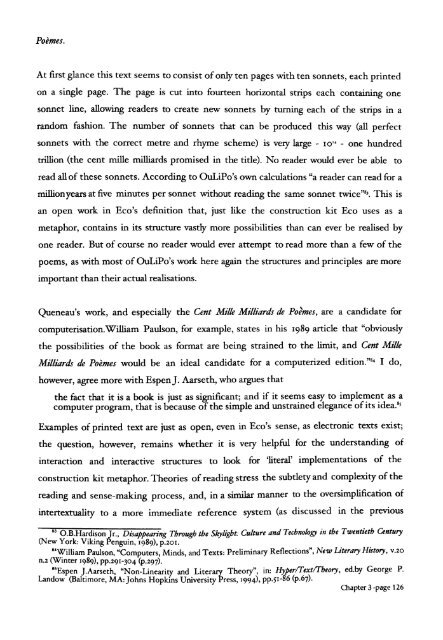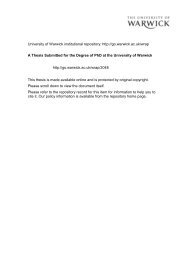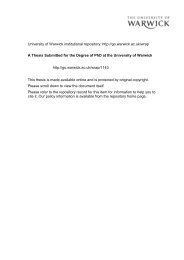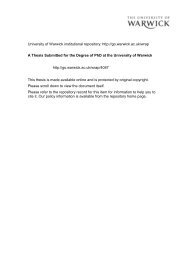From Page to Screen - WRAP: Warwick Research Archive Portal ...
From Page to Screen - WRAP: Warwick Research Archive Portal ...
From Page to Screen - WRAP: Warwick Research Archive Portal ...
You also want an ePaper? Increase the reach of your titles
YUMPU automatically turns print PDFs into web optimized ePapers that Google loves.
Poemes.<br />
At first glance this text seems <strong>to</strong> consist ofonly ten pages with ten sonnets, each printed<br />
on a single page. The page is cut in<strong>to</strong> fourteen horizontal strips each containing one<br />
sonnet line, allowing readers <strong>to</strong> create new sonnets by turning each of the strips in a<br />
random fashion. The number of sonnets that can be produced this way (all perfect<br />
sonnets with the correct metre and rhyme scheme) is very large - 10'4 - one hundred<br />
trillion (the cent mille milliards promised in the title). No reader would ever be able <strong>to</strong><br />
read allof these sonnets. According <strong>to</strong> OuLiPo's own calculations "a reader can read for a<br />
millionyears at five minutes per sonnet without reading the same sonnet twice?", This is<br />
an open work in Eco's definition that, just like the construction kit Eco uses as a<br />
metaphor, contains in its structure vastly more possibilities than can ever be realised by<br />
one reader. But of course no reader would ever attempt <strong>to</strong> read more than a few of the<br />
poems, as with most of OuLiPo's work here again the structures and principles are more<br />
important than their actual realisations.<br />
Queneau's work, and especially the Cent Mille Milliards de Poimes, are a candidate for<br />
computerisation.William Paulson, for example, states in his 1989 article that "obviously<br />
the possibilities of the book as format are being strained <strong>to</strong> the limit, and Cent Milk<br />
Milliards de Poemes would be an ideal candidate for a computerized edition.Y I do,<br />
however, agree more with Espen]. Aarseth, who argues that<br />
the fact that it is a book is just as significant; and if it seems easy <strong>to</strong> implement as a<br />
computer program, that is because ofthe simple and unstrained elegance ofits idea."<br />
Examples of printed text are just as open, even in Eco's sense, as electronic texts exist;<br />
the question, however, remains whether it is very helpful for the understanding of<br />
interaction and interactive structures <strong>to</strong> look for 'literal' implementations of the<br />
construction kit metaphor. Theories ofreading stress the subtlety and complexity of the<br />
reading and sense-making process, and, in a similar manner <strong>to</strong> the oversimplification of<br />
intertextua1ity <strong>to</strong> a more immediate reference system (as discussed in the previous<br />
83 O.B.Hardison Jr., Disappearing Through the Skylight: Culture and Technology in the Twentieth Century<br />
(New York: Viking Penguin, 1989), p.20I.<br />
84William Paulson, "Computers, Minds, and Texts: Preliminary Reflections", New Literary His<strong>to</strong>ry, V.20<br />
n.z (Winter 1989),PP.291-304 (P.297).<br />
85Espen J.Aarseth, "Non-Linearity and Literary Theory", in: HyperlTextffheory, ed.by George P.<br />
Landow (Baltimore, MA:Johns Hopkins University Press, 1994), PP·51-86 (p.67)·<br />
Chapter 3 -page 126





